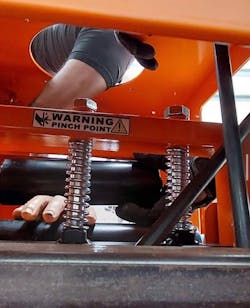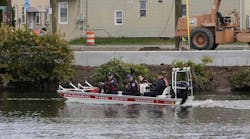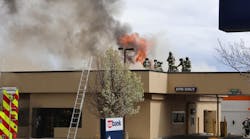Response to machinery incidents isn’t new. For centuries, people have used tools and equipment to execute certain tasks. After the wheel was invented in ancient Mesopotamia, there was a chance that something could go wrong, and someone could be injured as a result. Fast forward a couple of centuries and engineering started to advance with the invention of steam engines and such. Wheels started to move faster and faster.
This field of humans and machines is a constant struggle. People must respect and understand machines, but, at the end of the day, the machine always has the highest probability of winning in a human vs. machine encounter. It isn’t difficult to find video on social media of a horrible industrial accident where someone fell victim to the respective machine and was severely maimed or killed.
Machinery rescue operations that involve rollers and/or conveyor systems must be broken down into components to create a better formulated plan for rescuer technicians to mitigate such an incident.
Size-up
As firefighters and rescuers, the thing to do to begin a machinery rescue operation is to conduct a size-up. This process includes the environment of the incident, the machinery and the injured.
The environment is vital in operations, because it can influence the machinery, the patient and how we operate. For example, say someone’s hand got stuck in a snowblower, and on arrival, you face blizzard-like conditions. Do you attempt to move the entire operation to a garage, or are you prepared to set up a pop-up tent in the immediate vicinity to maintain a better working area for all who are involved?
The machinery presents its own laundry list of concerns for the rescue technician. How maintained is the machine itself? (If it’s a “well-oiled machine,” your ability to disassemble it might be easier than working through equipment that’s weathered and rusted.) Is it easy to secure power to it? Is the area in which the injured is entrapped easily accessible? Is there a hatch to access the respective area, or must you disassemble sections of the machine?
Regarding the injury, whether or not your department operates a medical component, the actions that you must execute absolutely affect the injury. In an incident that involves rollers and conveyors, there’s a high potential for crush injuries between all of the mechanical components that are involved.
Depending on the injury—whether it’s a finger, an arm or more of the body that’s involved—the body part will give way through the path of least resistance. Using an arm that’s in between two inline rollers as an example, there’s potential that the hand and forearm might pass through with only minor issues, such as scrapes and bruising; however, once the elbow area goes through the inline rollers, that’s where the bone will chalk the rollers. Without getting in depth into the muscular and tissue injuries, that becomes the pinch point of the area that must be opened to allow for the elbow to be freed.
Make sure that you always work closely with the medical resources that are available to you.
Physics and movement
Understanding rollers and conveyor systems comes down to understanding fundamental physics and movement. If something of lesser density moves with velocity through something of higher density, the forces react and tend to either get caught and lock in or to break through the object of lesser density. In basic terms, the human body loses most of the time when under force of machinery.
What happens if the body is capable of withstanding those forces and the person becomes entrapped in a roller or conveyor? Machinery rescue that’s similar to vehicle extrication comes down to removing the machinery (i.e., the vehicle) from around the patient compared with removing the patient from within the machinery. From the streets, we know that the latter concept isn’t always applicable because of the realistic conditions that we might encounter on scene.
As always, you must understand what equipment is available to you prior to encountering one of these machinery rescue incidents.
Lock out/tag out
When you operate at a machinery rescue incident that involves rollers and/or conveyors, lock out/tag out and understanding the operational consequences that might occur in the machinery are paramount. Securing power is vital to creating a safer operation for both responders and the patient.
If you have a maintenance or repair technician from the site of the incident available to you, make sure to include that individual when you formulate your operational plan. That person might know how the machine reacts and what components do what. Even more so, the technician might know what deenergizing the machine might do within the machine itself. Maybe without power, some internal components drop out and come off tension, or maybe the opposite occurs, and the components lock in until reset.
In case a maintenance or repair technician isn’t available on scene, you should know who to call to create that real-time dialogue. This also comes into consideration when you conduct your site survey or walk-through of a facility that’s in your response district. From a technical rescue perspective, ask what the machines do and who you can call in the event of issues.
Don’t forget to ask who is above the maintenance or repair technician in case that person is involved and can’t assist.
Operation simplicity
Keep the rescue operation simple. Don’t overthink it. Stabilize the problem and isolate the power. If you are able to access the entrapped area, lock it out and create your physical block by wedging or chalking the affected area. If practical, work through either disassembling or creating enough space to free the injury.
Be mindful to work in coordination with medical personnel. Some might call for tourniquets, and some might call for trauma doctors.
Know your resources. Every incident is different and requires you to execute tasks differently. As long as you analyze the problem, plan an operation, implement the plan and evaluate the operation (APIE), you will be able to be successful.
Preparation
How do you prepare for a machinery rescue? In addition to studying and taking every opportunity to work with machinery, there are options on the market that might assist you in honing your skills. These include companies that develop and produce props for roller system emergencies. One prop engages you to work through scenarios in which you might have to stabilize the victim and the rollers while they are removed from the “machinery.” Another prop allows you to create scenarios that involve roller and crush injuries in a confined machine where you might have access issues.
If props aren’t available to you, at a minimum, discuss the topic at the kitchen table or in the bays. The best course of action simply might be calling someone who works with the respective machinery or figuring out that you might have someone in your firehouse who works with the respective machinery.









